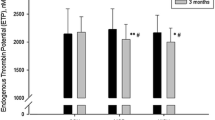Abstract
Background Age-related changes in blood coagulation and fibrinolytic factors are associated with an increase in risk of thrombotic events. The purpose of this study was to assess the effects of age, regular aerobic exercise and detraining on blood coagulation and fibrinolytic factors in men. Methods Initially, 41 sedentary and 42 physically active men (20–64 years) were analyzed for plasma levels of coagulation and fibrinolytic factors. Twelve sedentary men were then subjected to 16-week aerobic exercise training and subsequent 2-week detraining. Their blood samples taken at rest were assayed for activity levels of prothrombin, coagulation factor (F) V, VII, VIII, IX, X, XI and XIII, antithrombin III, protein C and plasminogen, and for antigen levels of fibrinogen, prothrombin fragment 1 + 2 (F1 + 2), FIX, protein C, tissue-type plasminogen activator (tPA), plasminogen activator inhibitor 1 (PAI-1) and tPA/PAI-1 complex. Results Plasma levels of most coagulation factors, particularly for fibrinogen and FIX antigens as well as FXIII activity significantly increased with aging in sedentary men, while that tendency disappeared in physically active men. By the exercise training, plasma antigen and/or activity levels of most blood coagulation factors except for prothrombin and FIX decreased. These training-effects, however, disappeared after detraining, and in some cases even rebounded to higher levels than those of pre-training. Plasma antigen levels of tPA, PAI-1 and tPA/PAI-1 complex decreased with the training and remained low even after detraining. Conclusion Regular aerobic exercises give complex effects on expression of hemostatic factors, overall favoring the hemostatic balance to less thrombotic, partly cancelling out the age effects.


Similar content being viewed by others
References
Abbate R, Prisco D, Rostagno C, Boddi M, Gensini GF (1993) Age-related changes in the hemostatic system. Int J Clin Lab Res 23:1–3
DeSouza CA, Jones PP, Seals DR (1998) Physical activity status and adverse age-related differences in coagulation and fibrinolytic factors in women. Arterioscler Thromb Vasc Biol 18:362–368
van den Burg PJ, Hospers JE, Mosterd WL, Bouma BN, Huisveld IA (2000) Aging, physical conditioning, and exercise-induced changes in hemostatic factors and reaction products. J Appl Physiol 88:1558–1564
Kurachi K, Kurachi S (2005) Molecular mechanisms of age-related regulation of genes. J Thromb Haemost 3:909–914
Kannel WB, Wolf PA, Castelli WP, D’Agostino RB (1987) Fibrinogen and risk of cardiovascular disease. The Framingham Study. Jama 258:1183–1186
Danesh J, Collins R, Appleby P, Peto R (1998) Association of fibrinogen, C-reactive protein, albumin, or leukocyte count with coronary heart disease: meta-analyses of prospective studies. Jama 279:1477–1482
Lowe GD, Yarnell JW, Sweetnam PM, Rumley A, Thomas HF, Elwood PC (1998) Fibrin D-dimer, tissue plasminogen activator, plasminogen activator inhibitor, and the risk of major ischaemic heart disease in the Caerphilly study. Thromb Haemost 79:129–133
Wannamethee SG, Lowe GD, Whincup PH, Rumley A, Walker M, Lennon L (2002) Physical activity and hemostatic and inflammatory variables in elderly men. Circulation 105:1785–1790
Smith DT, Hoetzer GL, Greiner JJ, Stauffer BL, DeSouza CA (2003) Effects of ageing and regular aerobic exercise on endothelial fibrinolytic capacity in humans. J Physiol 546:289–298
Stratton JR, Chandler WL, Schwartz RS, Cerqueira MD, Levy WC, Kahn SE, Larson VG, Cain KC, Beard JC, Abrass IB (1991) Effects of physical conditioning on fibrinolytic variables and fibrinogen in young and old healthy adults. Circulation 83:1692–1697
Ghiu IA, Ferrell RE, Kulaputana O, Phares DA, Hagberg JM (2004) Selected genetic polymorphisms and plasma coagulation factor VII changes with exercise training. J Appl Physiol 96:985–990
Adachi S (1996) Practical coagulation factor assays. Med Technol 24:629–633
Ranby M, Nguyen G, Scarabin PY, Samama M (1989) Immunoreactivity of tissue plasminogen activator and of its inhibitor complexes. Biochemical and multicenter validation of a two site immunosorbent assay. Thromb Haemost 61:409–414
Fickenscher K, Aab A, Stuber W (1991) A photometric assay for blood coagulation factor XIII. Thromb Haemost 65:535–540
Friberger P, Knos M, Gustavsson S, Aurell L, Claeson G (1978) Methods for determination of plasmin, antiplasmin and plasminogen by means of substrate S-2251. Haemostasis 7:138–145
Okajima K (1995) [Antithrombin III (AT III)]. Nippon Rinsho 53(Su Pt 2):43–47
Goto S, Handa S, Abe S, Takahashi E, Kawai Y, Watanabe K, Yoshikawa T, Hori S, Ikeda Y (1993) Serial changes in hemostatic and fibrinolytic states induced by coronary thrombolytic therapy. J Cardiol 23:335–341
Tanaka H, Clevenger CM, Jones PP, Seals DR, DeSouza CA (1998) Influence of body fatness on the coronary risk profile of physically active postmenopausal women. Metabolism 47:1112–1120
Miwa K, Nakagawa K, Yoshida N, Taguchi Y, Inoue H (2000) Lipoprotein(a) is a risk factor for occurrence of acute myocardial infarction in patients with coronary vasospasm. J Am Coll Cardiol 35:1200–1205
Tanaka H, Monahan KD, Seals DR (2001) Age-predicted maximal heart rate revisited. J Am Coll Cardiol 37:153–156
Hayashi K, Sugawara J, Komine H, Maeda S, Yokoi T (2005) Effects of aerobic exercise training on stiffness of central and peripheral arteries in middle-aged sedentary men. Jpn J Physiol 55:235–239
Bostom AG, Cupples LA, Jenner JL, Ordovas JM, Seman LJ, Wilson PW, Schaefer EJ, Castelli WP (1996) Elevated plasma lipoprotein(a) and coronary heart disease in men aged 55 years and younger. A prospective study. Jama 276:544–548
Mackinnon LT, Hubinger LM (1999) Effects of exercise on lipoprotein(a). Sports Med 28:11–24
Author information
Authors and Affiliations
Corresponding author
Rights and permissions
About this article
Cite this article
Sugawara, J., Hayashi, K., Kurachi, S. et al. Age-related effects of regular physical activity on hemostatic factors in men. J Thromb Thrombolysis 26, 203–210 (2008). https://doi.org/10.1007/s11239-007-0092-y
Received:
Accepted:
Published:
Issue Date:
DOI: https://doi.org/10.1007/s11239-007-0092-y



